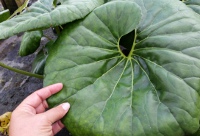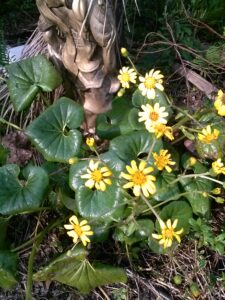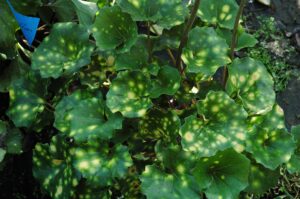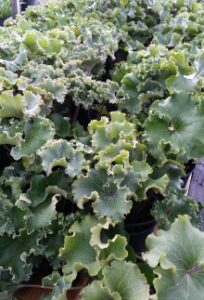S & J Nursery’s Guide to Growing
Farfugium japonicum
/ Leopard Plants
in the Northeast Florida Landscape
( Farfugium Japonicum)
 Farfugium Japonicum / Ligularia / Leopard Plant / Tractor Seat Plant….The list just keeps
Farfugium Japonicum / Ligularia / Leopard Plant / Tractor Seat Plant….The list just keeps
growing!
Farfugium is one of those new introductions that growers keep trying to stick another common name onto and none of those names seem to want to stick around a while. Nobody seems to want to call these hardy landscape plants by their actual name. Would it harm us in some way to just call something by it’s binomial nomenclature given to it by the expert botanists and avoid unnecessary confusion with other plants of different species?
No, I guess not, but those same experts will just change their minds about what plant family it belongs to in another year or two and change it again like they changed it from Ligularia to Farfugium. (Rant much anyone? Ok, I am done I promise, science the ever changing fact book)… so in true nurserymen fashion, we just keep renaming them in the hope that the new fabulous common name will help the plant magically disappear from the retail shelves they are displayed on. If Farfugium japonicum is to much of a mouthful, what in the world DO YOU call these plants? They are so unusual and unique. Truly a gardeners dream.
 There is nothing like them. Big showy stalks of daisy-like blooms on thick leathery leaves that look like they belong on the set of a Jurassic Park movie.
There is nothing like them. Big showy stalks of daisy-like blooms on thick leathery leaves that look like they belong on the set of a Jurassic Park movie.
Dinosaur foot? Why not, we call Alocasias and Colocasias Elephant Ear Plants! See, there I go, needing a better name to call these fantastic plants! I love them and something must be ingrained in
my nursery plant growing mind that in order to convince you to love them I must come up with a fantastic new name to call them!
Well I do love them, I have found that gardeners that I show them to either instantly love them or they instantly hate them. There seems to be no middle ground. I was, of course, in the instantly love them group and have grabbed up every cultivar I have run across since the day I first saw them. There are spotted farfugiums that remind me of a cloudless sky on a starry night, there are big bold 12 -15 inch wide farfugium that have dark green shiny leaves that grab your attention. Then there are soft gray
green Farfugium with beautifully ruffled leaves and almost a velvety look to the foliage.
One of the “starry night” cultivars as I call them, Farfugium  ‘Aureomaculatum’ ,was awarded the Royal Horticultural Society’s Award of Garden Merit, so if you love them, you’re in good company!
‘Aureomaculatum’ ,was awarded the Royal Horticultural Society’s Award of Garden Merit, so if you love them, you’re in good company!
These easy to care for plants are quickly gaining popularity. I am seeing even more selections available to grow with a combination of any of those characteristics. It seems that all of them have the beautiful stalks of bright and cheery yellow fall flowers each year that I fell in love with in the first place.
Farfugium japonicum hails from the east and can be found in their native land of Japan, growing happily and hardily, much like they do here in our Northeast Florida landscape.
Protecting Your Farfugium Plants From Winter Temperatures
Here in our Northeast Florida subtropical climate zones, these plants are hardy perennials that need no winter protection. They remain evergreen here in our zone 9 Jacksonville and St. Augustine Florida area gardens.
Where to Plant Your Farfugium japonicum / Leopard Plant / Tractor Seat Plant
Selections
Best suited to moist but well drained and not wet or soggy soils. Amend soil generously with compost when planting as they prefer humousy soils.
generously with compost when planting as they prefer humousy soils.
Farfugium can be planted into partial sun/shade areas of the landscape and grow well under dappled shade from taller trees and palms.
When planted into a sunnier location more frequent irrigation may be needed to keep the plants upright and happy as they tend to wilt with the heat during dry spells here in Florida. Don’t let that
deter you from planting them. These plants are great “moisture meters” as they will be the first to let you know
when the soil is too dry. Farfugium is also very forgiving and will bounce back up from it’s wilted state quickly when watered.
For people like me who don’t leave their irrigation systems on a preset clock and only water on an “as needed” basis, they are the perfect ‘moisture sensors’. When planted among sensitive plants that may
not be so forgiving of lack of attention they will wilt and let you know it is time to water. You can spot water needs before it is too late for your less forgiving plant selections.
Farfugiums are said to grow along rocky coastal cliffs in their native lands, so it is a fairly safe assumption that they will fare well as a coastal landscape planting here in our Northeast
Florida landscapes but I am unable to scrounge up enough information on these plants to confirm their level of
salt tolerance.

